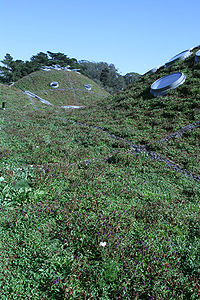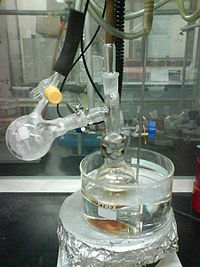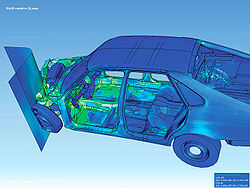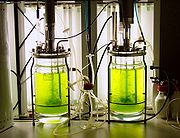
Environmental Engineering Science
Encyclopedia

Thermodynamics
Thermodynamics is a physical science that studies the effects on material bodies, and on radiation in regions of space, of transfer of heat and of work done on or by the bodies or radiation...
, advanced math, computer modeling and simulation
Simulation
Simulation is the imitation of some real thing available, state of affairs, or process. The act of simulating something generally entails representing certain key characteristics or behaviours of a selected physical or abstract system....
as well as technical classes in subjects such as statics
Statics
Statics is the branch of mechanics concerned with the analysis of loads on physical systems in static equilibrium, that is, in a state where the relative positions of subsystems do not vary over time, or where components and structures are at a constant velocity...
, mechanics
Mechanics
Mechanics is the branch of physics concerned with the behavior of physical bodies when subjected to forces or displacements, and the subsequent effects of the bodies on their environment....
, hydrology
Hydrology
Hydrology is the study of the movement, distribution, and quality of water on Earth and other planets, including the hydrologic cycle, water resources and environmental watershed sustainability...
, and fluid dynamics
Fluid dynamics
In physics, fluid dynamics is a sub-discipline of fluid mechanics that deals with fluid flow—the natural science of fluids in motion. It has several subdisciplines itself, including aerodynamics and hydrodynamics...
. As the student progresses, the upper division elective classes define a specific field of study for the student with a choice in a wide range of science, technology and engineering related classes:
Difference with related fields

Environment (biophysical)
The biophysical environment is the combined modeling of the physical environment and the biological life forms within the environment, and includes all variables, parameters as well as conditions and modes inside the Earth's biosphere. The biophysical environment can be divided into two categories:...
focused professionals . It should be noted in the few engineering colleges that offer this major, the curriculum shares more classes in common with environmental engineering
Environmental engineering
Environmental engineering is the application of science and engineering principles to improve the natural environment , to provide healthy water, air, and land for human habitation and for other organisms, and to remediate polluted sites...
than it does with environmental science
Environmental science
Environmental science is an interdisciplinary academic field that integrates physical and biological sciences, to the study of the environment, and the solution of environmental problems...
. Typically, EES students follow a similar course curriculum with environmental engineers until their fields diverge during the last year of college. While, a majority of the environmental engineering students must take classes designed to connect their knowledge of the environment to modern building materials and construction
Construction
In the fields of architecture and civil engineering, construction is a process that consists of the building or assembling of infrastructure. Far from being a single activity, large scale construction is a feat of human multitasking...
methods. This is meant to steer the environmental engineer into a field where they will more than likely assist in building treatment facilities
Wastewater Treatment
Wastewater treatment may refer to:* Sewage treatment* Industrial wastewater treatment...
, preparing environmental impact assessment
Environmental impact assessment
An environmental impact assessment is an assessment of the possible positive or negative impact that a proposed project may have on the environment, together consisting of the natural, social and economic aspects....
s or helping to mitigate air pollution
Air pollution
Air pollution is the introduction of chemicals, particulate matter, or biological materials that cause harm or discomfort to humans or other living organisms, or cause damage to the natural environment or built environment, into the atmosphere....
from specific point sources.
Meanwhile, the environmental engineering science student will choose a direction for their career
Career
Career is defined by the Oxford English Dictionary as a person's "course or progress through life ". It is usually considered to pertain to remunerative work ....
. From the wide range of electives they have to choose from, these students can move into a wide range of fields in anything from the design of nuclear storage facilities
Radioactive waste
Radioactive wastes are wastes that contain radioactive material. Radioactive wastes are usually by-products of nuclear power generation and other applications of nuclear fission or nuclear technology, such as research and medicine...
, bacterial bioreactors or environmental policies. With this in mind, it is important to note that these students combine the practical design background of an engineer with the detailed theory found in many of the biological
Biology
Biology is a natural science concerned with the study of life and living organisms, including their structure, function, growth, origin, evolution, distribution, and taxonomy. Biology is a vast subject containing many subdivisions, topics, and disciplines...
and physical sciences. In other words, these students have the capabilities to imagine, design
Design
Design as a noun informally refers to a plan or convention for the construction of an object or a system while “to design” refers to making this plan...
and build ideas from many interconnected disciplines concerned with the healthy fate of our environment.
UC Berkeley
The College of Engineering at UC Berkeley defines Environmental Engineering Science as follows
This is a multidisciplinary field requiring an integration of physical, chemical and biological principles with engineering analysis for environmental protection and restoration. The program incorporates courses from many departments on campus to create a discipline that is rigorously based in science and engineering, while addressing a wide variety of environmental issues. Although an environmental engineering option exists within the civil engineering major, the engineering science curriculum provides a more broadly based foundation in the sciences than is possible in civil engineering. This major prepares the student for a career or graduate study in many environmental areas.
Massachusetts Institute of Technology
At MIT, the major is described in their curriculum and says
The Bachelor of Science in Environmental Engineering Science emphasizes the fundamental physical, chemical, and biological processes necessary for understanding the interactions between man and the environment. Issues considered include the provision of clean and reliable water supplies, flood forecasting and protection, development of renewable and nonrenewable energy sources, causes and implications of climate change, and the impact of human activities on natural cycles. Both programs provide awareness of the
sociopolitical context in which civil and environmental engineering problems are solved. Premedical students may satisfy medical school
entrance requirements while earning the accredited degree in environmental engineering science with proper planning of their program.

Lower division coursework
Lower division coursework in this field requires the student to take several laboratory-based classes in calculus-based physics, chemistry, biology, programming and analysisAnalysis
Analysis is the process of breaking a complex topic or substance into smaller parts to gain a better understanding of it. The technique has been applied in the study of mathematics and logic since before Aristotle , though analysis as a formal concept is a relatively recent development.The word is...
. This is intended to give the student background information in order to introduce them to the engineering fields as well as prepare them for more technical information in their upper division coursework.
Upper division coursework

- Fluid mechanicsFluid mechanicsFluid mechanics is the study of fluids and the forces on them. Fluid mechanics can be divided into fluid statics, the study of fluids at rest; fluid kinematics, the study of fluids in motion; and fluid dynamics, the study of the effect of forces on fluid motion...
- MechanicsMechanicsMechanics is the branch of physics concerned with the behavior of physical bodies when subjected to forces or displacements, and the subsequent effects of the bodies on their environment....
of materials - ThermodynamicsThermodynamicsThermodynamics is a physical science that studies the effects on material bodies, and on radiation in regions of space, of transfer of heat and of work done on or by the bodies or radiation...
- Environmental engineeringEnvironmental engineeringEnvironmental engineering is the application of science and engineering principles to improve the natural environment , to provide healthy water, air, and land for human habitation and for other organisms, and to remediate polluted sites...
- Advanced math and statisticsStatisticsStatistics is the study of the collection, organization, analysis, and interpretation of data. It deals with all aspects of this, including the planning of data collection in terms of the design of surveys and experiments....
- GeologyGeologyGeology is the science comprising the study of solid Earth, the rocks of which it is composed, and the processes by which it evolves. Geology gives insight into the history of the Earth, as it provides the primary evidence for plate tectonics, the evolutionary history of life, and past climates...
- PhysicalPhysical chemistryPhysical chemistry is the study of macroscopic, atomic, subatomic, and particulate phenomena in chemical systems in terms of physical laws and concepts...
, organicOrganic chemistryOrganic chemistry is a subdiscipline within chemistry involving the scientific study of the structure, properties, composition, reactions, and preparation of carbon-based compounds, hydrocarbons, and their derivatives...
and atmospheric chemistryAtmospheric chemistryAtmospheric chemistry is a branch of atmospheric science in which the chemistry of the Earth's atmosphere and that of other planets is studied. It is a multidisciplinary field of research and draws on environmental chemistry, physics, meteorology, computer modeling, oceanography, geology and... - BiochemistryBiochemistryBiochemistry, sometimes called biological chemistry, is the study of chemical processes in living organisms, including, but not limited to, living matter. Biochemistry governs all living organisms and living processes...
- MicrobiologyMicrobiologyMicrobiology is the study of microorganisms, which are defined as any microscopic organism that comprises either a single cell , cell clusters or no cell at all . This includes eukaryotes, such as fungi and protists, and prokaryotes...
- EcologyEcologyEcology is the scientific study of the relations that living organisms have with respect to each other and their natural environment. Variables of interest to ecologists include the composition, distribution, amount , number, and changing states of organisms within and among ecosystems...
Process engineering
On this track, students are introduced to the fundamental reaction mechanisms in the field of chemical and biochemical engineering. See also Process engineeringProcess engineering
Process engineering focuses on the design, operation, control, and optimization of chemical, physical, and biological processes through the aid of systematic computer-based methods...
Resource engineering
For this track, students are encouraged to take classes introducing them to various ways to conserve natural resources. This can include but is not limited to classes in water chemistry, sanitationSanitation
Sanitation is the hygienic means of promoting health through prevention of human contact with the hazards of wastes. Hazards can be either physical, microbiological, biological or chemical agents of disease. Wastes that can cause health problems are human and animal feces, solid wastes, domestic...
, combustion
Combustion
Combustion or burning is the sequence of exothermic chemical reactions between a fuel and an oxidant accompanied by the production of heat and conversion of chemical species. The release of heat can result in the production of light in the form of either glowing or a flame...
, air pollution
Air pollution
Air pollution is the introduction of chemicals, particulate matter, or biological materials that cause harm or discomfort to humans or other living organisms, or cause damage to the natural environment or built environment, into the atmosphere....
and radioactive waste
Radioactive waste
Radioactive wastes are wastes that contain radioactive material. Radioactive wastes are usually by-products of nuclear power generation and other applications of nuclear fission or nuclear technology, such as research and medicine...
management.
Ecology
Prepares the students for using their engineering and scientific know how to solve the interactions between plants, animals and the biosphere. See also EcologyEcology
Ecology is the scientific study of the relations that living organisms have with respect to each other and their natural environment. Variables of interest to ecologists include the composition, distribution, amount , number, and changing states of organisms within and among ecosystems...
Biology
Gives the environmental engineering science student a more advanced knowledge of microbial, molecular and cell biology. Classes can include cell biologyCell biology
Cell biology is a scientific discipline that studies cells – their physiological properties, their structure, the organelles they contain, interactions with their environment, their life cycle, division and death. This is done both on a microscopic and molecular level...
, virology
Virology
Virology is the study of viruses and virus-like agents: their structure, classification and evolution, their ways to infect and exploit cells for virus reproduction, the diseases they cause, the techniques to isolate and culture them, and their use in research and therapy...
, microbial
Microbiology
Microbiology is the study of microorganisms, which are defined as any microscopic organism that comprises either a single cell , cell clusters or no cell at all . This includes eukaryotes, such as fungi and protists, and prokaryotes...
and plant biology
Policy
Gives the students a more rigorous look at ways improve our environment through political means. This is done by introducing students to both qualitative and quantitative tools in classes such as economicsEconomics
Economics is the social science that analyzes the production, distribution, and consumption of goods and services. The term economics comes from the Ancient Greek from + , hence "rules of the house"...
, sociology
Sociology
Sociology is the study of society. It is a social science—a term with which it is sometimes synonymous—which uses various methods of empirical investigation and critical analysis to develop a body of knowledge about human social activity...
, political science
Political science
Political Science is a social science discipline concerned with the study of the state, government and politics. Aristotle defined it as the study of the state. It deals extensively with the theory and practice of politics, and the analysis of political systems and political behavior...
as well as energy and resources.
Post graduation work

Civil engineering
Civil engineering is a professional engineering discipline that deals with the design, construction, and maintenance of the physical and naturally built environment, including works like roads, bridges, canals, dams, and buildings...
and environmental engineering
Environmental engineering
Environmental engineering is the application of science and engineering principles to improve the natural environment , to provide healthy water, air, and land for human habitation and for other organisms, and to remediate polluted sites...
, biotechnology
Biotechnology
Biotechnology is a field of applied biology that involves the use of living organisms and bioprocesses in engineering, technology, medicine and other fields requiring bioproducts. Biotechnology also utilizes these products for manufacturing purpose...
, and research. However, the less technical math, programming and writing background gives the students opportunities to pursue IT
Information technology
Information technology is the acquisition, processing, storage and dissemination of vocal, pictorial, textual and numerical information by a microelectronics-based combination of computing and telecommunications...
work and technical writing
Technical writing
Technical writing, a form of technical communication, is a style of writing used in fields as diverse as computer hardware and software, engineering, chemistry, the aerospace industry, robotics, finance, consumer electronics, and biotechnology....
.
See also
- Civil engineeringCivil engineeringCivil engineering is a professional engineering discipline that deals with the design, construction, and maintenance of the physical and naturally built environment, including works like roads, bridges, canals, dams, and buildings...
- Environmental engineeringEnvironmental engineeringEnvironmental engineering is the application of science and engineering principles to improve the natural environment , to provide healthy water, air, and land for human habitation and for other organisms, and to remediate polluted sites...
- Environmental scienceEnvironmental scienceEnvironmental science is an interdisciplinary academic field that integrates physical and biological sciences, to the study of the environment, and the solution of environmental problems...
- SustainabilitySustainabilitySustainability is the capacity to endure. For humans, sustainability is the long-term maintenance of well being, which has environmental, economic, and social dimensions, and encompasses the concept of union, an interdependent relationship and mutual responsible position with all living and non...
- Green buildingGreen buildingGreen building refers to a structure and using process that is environmentally responsible and resource-efficient throughout a building's life-cycle: from siting to design, construction, operation, maintenance, renovation, and demolition...
- Sustainable engineeringSustainable engineeringSustainable engineering is the process of using energy and resources at a rate that does not compromise the natural environment, or the ability of future generations to meet their own needs.-What engineers can do:*Water supply*Food production...
External links
- Engineering Engineering and Science program at Stanford University http://www.stanford.edu/group/ees/
- What people go on to do in Engineering Science at UC Berkeley http://career.berkeley.edu/Major2006/EngrSci.stm
- Curriculum at University of Florida http://www.ees.ufl.edu/prospective/undergrad/curriculum.asp
- Curriculum at MIT http://web.mit.edu/catalogue/degre.engin.ch1e.shtml
- Curriculum at University of Illinois http://cee.uiuc.edu/environmental/Academic/UndergradProgram.html

